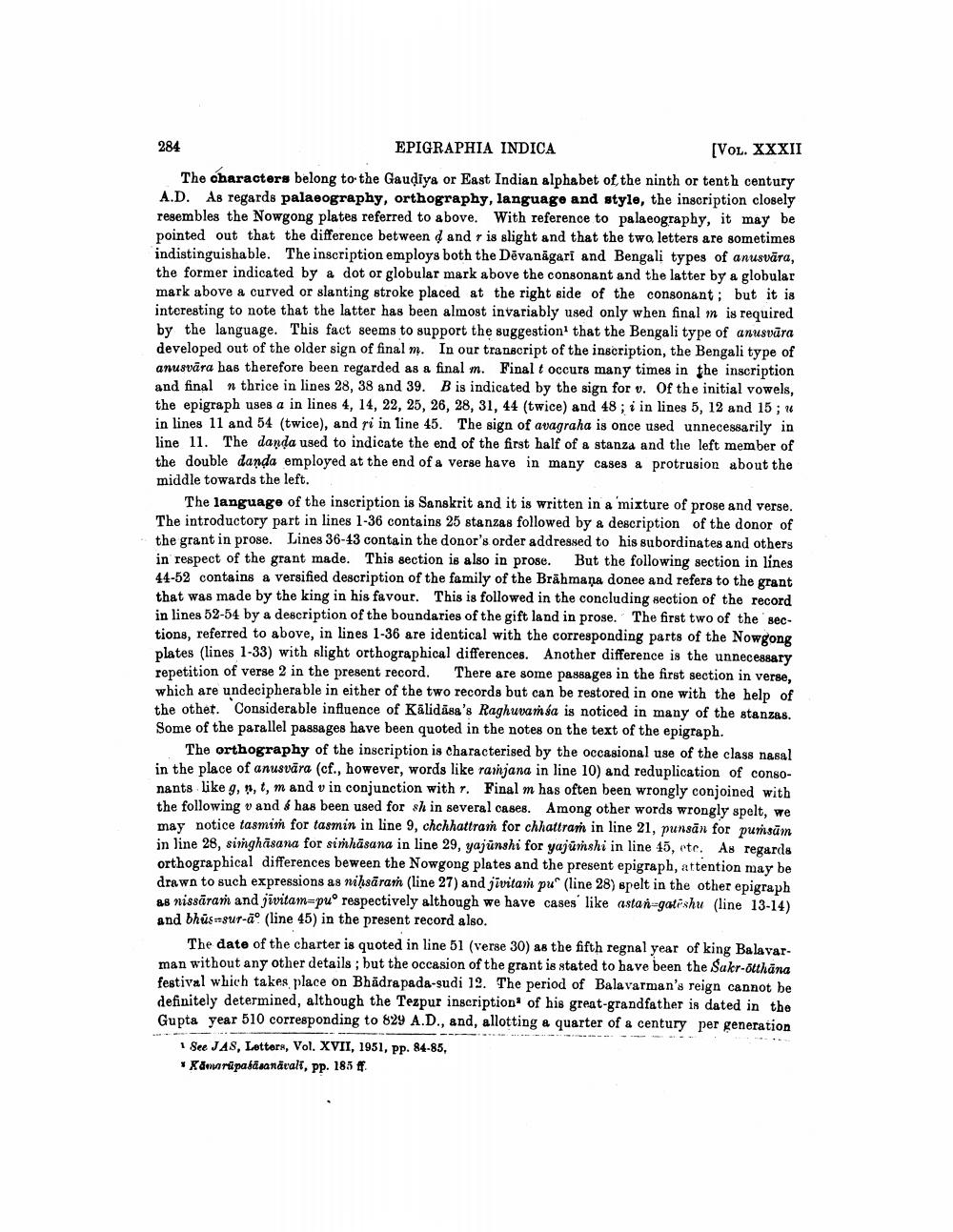________________
284 EPIGRAPHIA INDICA
[VOL. XXXII The characters belong to the Gaudiya or East Indian alphabet of the ninth or tenth century A.D. As regards palaeography, orthography, language and style, the inscription closely resembles the Nowgong plates referred to above. With reference to palaeography, it may be pointed out that the difference between d and r is slight and that the two letters are sometimes indistinguishable. The inscription employs both the Devanagari and Bengali types of anusvāra, the former indicated by a dot or globular mark above the consonant and the latter by a globular mark above a curved or slanting stroke placed at the right side of the consonant; but it is interesting to note that the latter has been almost invariably used only when final mn is required by the language. This fact seems to support the suggestion that the Bengali type of anusvāra developed out of the older sign of final m. In our transcript of the inscription, the Bengali type of anusvāra has therefore been regarded as a final m. Final t occurs many times in the inscription and final n thrice in lines 28, 38 and 39. B is indicated by the sign for v. Of the initial vowels, the epigraph uses a in lines 4, 14, 22, 25, 26, 28, 31, 44 (twice) and 48 ; i in lines 5, 12 and 15; in lines 11 and 54 (twice), and si in line 45. The sign of avagraha is once used unnecessarily in line 11. The danda used to indicate the end of the first half of a stanza and the left member of the double danda employed at the end of a verse have in many cases a protrusion about the middle towards the left.
The language of the inscription is Sanskrit and it is written in a mixture of prose and verse. The introductory part in lines 1-36 contains 25 stanzas followed by a description of the donor of the grant in prose. Lines 36-43 contain the donor's order addressed to his subordinates and others in respect of the grant made. This section is also in prose. But the following section in lines 44-52 contains a versified description of the family of the Brāhmaṇa donee and refers to the grant that was made by the king in his favour. This is followed in the concluding section of the record in lines 52-54 by a description of the boundaries of the gift land in prose. The first two of the Bections, referred to above, in lines 1-36 are identical with the corresponding parts of the Nowgong plates (lines 1-33) with slight orthographical differences. Another difference is the unnecessary repetition of verse 2 in the present record. There are some passages in the first section in verse, which are undecipherable in either of the two records but can be restored in one with the help of the othet. Considerable influence of Kālidāsa's Raghuvansa is noticed in many of the stanzas. Some of the parallel passages have been quoted in the notes on the text of the epigraph.
The orthography of the inscription is characterised by the occasional use of the class nasal in the place of anusvära (cf., however, words like ranjana in line 10) and reduplication of consonants like g, , , m and v in conjunction with T. Final m has often been wrongly conjoined with the following v and has been used for sh in several cases. Among other words wrongly spelt, we may notice tasmin for tasmin in line 9, chchhattram for chhattrar in line 21, punsān for pursām in line 28, singhäsana for simhāsana in line 29, yajūnshi for yajūrnshi in line 45, etc. As regards orthographical differences beween the Nowgong plates and the present epigraph, attention may be drawn to such expressions as wihsāram (line 27) and jivitani pu (line 28) spelt in the other epigraph as nissāram and jivitam=pu respectively although we have cases like astan-gatishu (line 13-14) and bhūs=-sur-a. (line 45) in the present record also.
The date of the charter is quoted in line 51 (verse 30) as the fifth regnal year of king Balavarman without any other details; but the occasion of the grant is stated to have been the Sakr-Otthāna festival which takes place on Bhadrapada-sudi 12. The period of Balavarman's reign cannot be definitely determined, although the Tezpur inscription of his great-grandfather is dated in the Gupta year 510 corresponding to 829 A.D., and, allotting a quarter of a century per generation
See JAS, Lottorn, Vol. XVII, 1951, pp. 84-85, * Kanvarüpasāsanāralt, pp. 185 ff.




